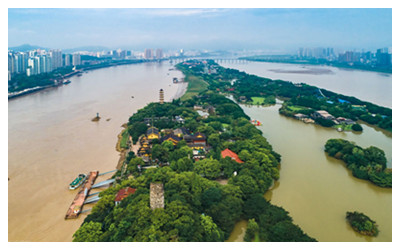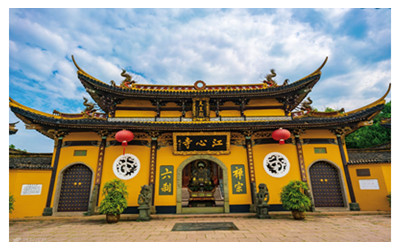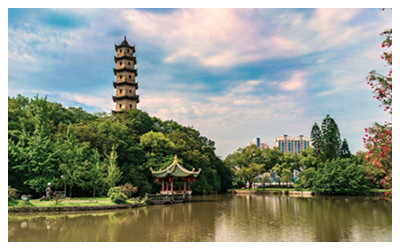Skype: neodalle-travel
Tel: +86 135 7447 2266
E-mail: sales@visitaroundchina.com
What to see?
 Jiangxinyu island features various kinds of old green trees, such as the approximately thousand year-old banyan, the eight hundred year-old camphor tree and the four hundred year-old olive. Other species growing there include fragrant flowers, water plants and ferns. Among its most appealing features are the drizzle in spring, sunglow at sea, moonlight on the Oujiang River, bonfire on the shoal and limpid springs. Another natural attraction is the Bonsai Garden, which displays a variety of the middle and small sized bonsai trees. Also displayed are the micro sceneries of the Hezhang Peak and Guanyin Cave of Yandang Mountain.
Jiangxinyu island features various kinds of old green trees, such as the approximately thousand year-old banyan, the eight hundred year-old camphor tree and the four hundred year-old olive. Other species growing there include fragrant flowers, water plants and ferns. Among its most appealing features are the drizzle in spring, sunglow at sea, moonlight on the Oujiang River, bonfire on the shoal and limpid springs. Another natural attraction is the Bonsai Garden, which displays a variety of the middle and small sized bonsai trees. Also displayed are the micro sceneries of the Hezhang Peak and Guanyin Cave of Yandang Mountain.
Wen Tianxiang Memorial Hall: To the east of the Jiangxin Temple lies the Wen Tianxiang Memorial Hall. Wen was a great national hero as well as a famous poet in the Song Dynasty. He led the army to fight with Yuan invaders who built the latter Yuan Dynasty (1271-1368). Finally, he was captured and killed by the invaders. The Hall displays a famous poem named 'Zheng Qi Ge' written by him and 20 steles inscribed with poems commemorating him. The Haoran Pavilion is situated to the east of the Wen Tianxiang Memorial Hall. Built in 1580, the pavilion features a unique wooden structure and has three rooms with a double-eaved roof.
 Jiangxin Temple: It was rebuilt in 1789 and encompasses approximately 2,870 square meters (1 acre). The temple is comprised of four parts: The Heavenly Guardians Hall; the Main Hall; the Three Saints Hall; the Abbot's Room. To the left and right of the Heavenly Guardians Hall are the Bell Tower and Drum Tower. A bell of Song Dynasty (960-1279) is preserved in the Bell Tower. Sculptures of Sakyamuni and other Buddhas are located in the Main Hall, which also houses a superb collection of couplets and plaques. Three Saints Hall features sculptures of the Goddess of Mercy, Maitreya and Mahasthamaprapta. Between the Main Hall and the Three Saints Hall stands the Seven-Buddha Pagoda built in Later Liang (907-923). The abbot's room is located to the west of the Main Hall, and features some precious sutras and pictures.
Jiangxin Temple: It was rebuilt in 1789 and encompasses approximately 2,870 square meters (1 acre). The temple is comprised of four parts: The Heavenly Guardians Hall; the Main Hall; the Three Saints Hall; the Abbot's Room. To the left and right of the Heavenly Guardians Hall are the Bell Tower and Drum Tower. A bell of Song Dynasty (960-1279) is preserved in the Bell Tower. Sculptures of Sakyamuni and other Buddhas are located in the Main Hall, which also houses a superb collection of couplets and plaques. Three Saints Hall features sculptures of the Goddess of Mercy, Maitreya and Mahasthamaprapta. Between the Main Hall and the Three Saints Hall stands the Seven-Buddha Pagoda built in Later Liang (907-923). The abbot's room is located to the west of the Main Hall, and features some precious sutras and pictures.
Xingqing Temple: It is another famous ancient building. Outside the Xingqing Temple, the Liuli Spring runs with cool water. The spring is one of the three most famous springs in Wenzhou. There is an old olive inside the temple, which is said to have been planted in 1587. The Wenzhou Museum is located in the temple and features cultural relics on display.
 The East and West Pagodas : These are the most eye-catching buildings on Jiangxinyu Island. Rebuilt in 1141, the East Pagoda is a six-side and seven-storey pagoda. It is about 28 meters (92 feet) high and 8 meters (26 feet) in diameter at the bottom. On the top, the pagoda features a banyan with green leaves all the year round. The West Pagoda is built in the style of the Song Dynasty. It is also a six-side and seven-storey pagoda. Larger than the East Pagoda, it is about 32 meters (105 feet) high and 7 meters (23 feet) in diameter at the bottom. There is a small Buddha niche on each storey with a stone Buddha sculpture in it. Near each pagoda lie two stone steles and a pavilion. Visitors can rest in the pavilion and enjoy the stone steles.
The East and West Pagodas : These are the most eye-catching buildings on Jiangxinyu Island. Rebuilt in 1141, the East Pagoda is a six-side and seven-storey pagoda. It is about 28 meters (92 feet) high and 8 meters (26 feet) in diameter at the bottom. On the top, the pagoda features a banyan with green leaves all the year round. The West Pagoda is built in the style of the Song Dynasty. It is also a six-side and seven-storey pagoda. Larger than the East Pagoda, it is about 32 meters (105 feet) high and 7 meters (23 feet) in diameter at the bottom. There is a small Buddha niche on each storey with a stone Buddha sculpture in it. Near each pagoda lie two stone steles and a pavilion. Visitors can rest in the pavilion and enjoy the stone steles.
Jiangxin Park: It is situated in the west of the island. It can be divided into two scenic areas: the Little Flying Rainbow Scenic Area and the Happiness City. A series of pavilions, verandas and terraces are built near the lake in the Little Flying Rainbow Scenic Area. The recreational facilities in the Happiness City will add additional entertainment to your trip.
Travel Tips
Add: Wangjiang Dong Road, Lucheng District, Wenzhou City,Zhejiang Province
Opening Hours:08:00-18:00
Entrance Fee: CNY CNY 25 (including the ferry fee)
 Ask Questions ?
Ask Questions ?